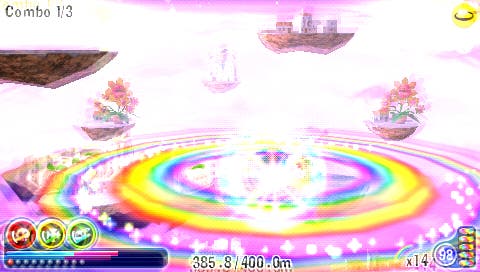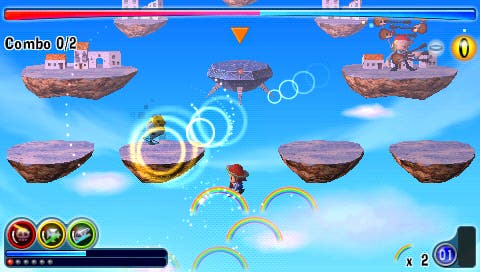Rainbow Islands Evolution
Bungled.
Evolution scares me. Not in the same way that it scares evangelical Alabama hillbillies who think God planted dinosaur fossils as some enormous cosmic prank, but in the way it's often applied to modern updates of classic games. In that context, "evolution" usually translates to "we pretty much changed everything - so it must be better."
It's a mindset that has produced nothing but punches to the sack for fans of Taito's venerable arcade classics in recent years. Having previously sullied the memories ofSpace Invaders and Bubble Bobble, neither of which could claw their way from the bottom of our scoring system, Rising Star now turns its baleful attention to a second stab at revitalising Rainbow Islands.
Readers of a nervous disposition should look away now. Seriously. Look over there. Oooh! It's a squirrel!
I evolve. I don't...revolve.

It's the timing that makes this one sting that little bit more. See, it plopped through my letterbox in the same week that After Burner: Black Falcon stroked my hair and showed me that retro games could be modernised without losing their soul. This was also the week that Jetpac Refuelled hit Live Arcade, proving that the simplest concepts really don't need anything more than some spit and polish to make them acceptable today. Compared to two retro updates that quite simply get it the sheer mind-boggling mess of this supposedly "evolved" Rainbow Islands is even more depressing. While last years DS "revolution" edition made excessive use of the touchpad to both draw rainbows and drag our heroes around the screen, for the PSP they've introduced a whole new catalogue of poor design decisions.
Let's start with the visuals, which have taken the bright and cheery graphics of old and, for no apparent reason, turned them all Mexican. The characters now sport sombreros and ponchos, and the overall effect is how you'd imagine Harvest Moon might look if Speedy Gonzales staged a hostile takeover. Also apropos of nothing, Bubby and Bobby (nee Bub and Bob) are now battling an evil record company and come armed with hurdy-gurdies. No, not Core Design's obscure sheep-herding game, but the medieval musical instrument - sort of like a cross between a piano and an accordion, but with a handle to wind it up. It's this which apparently spews forth the rainbows that still act as your improvised platforms and primary weapon. Why? Er, just because.
If those were the only changes made then it would still, at least, resemble the game we know and love. But where's the evolution in that? Also added to the already overegged pudding are numerous changes and additions to the tried and trusted gameplay, none of which add anything of value but are more than enough to dilute the basic appeal.
Up above the streets and houses

At the most fundamental level, the rainbows have changed. You now have a limited supply - starting with six - and rather than shattering when you jump on them, they can now survive two jumps with the first impact merely weakening them. As you're constantly using the rainbows to clamber up to the sparse platforms overhead, you can often be left stranded - forced to wait for your old rainbows to fade away before you spawn new ones. This fundamentally changes the way you use the rainbows, which wouldn't automatically be a bad thing were it not for the fact that there's no real reason for the change. It slows down the pace, yet the game offers nothing to fill this void. The game simply feels more stilted, clumsier.
At the other end of the scale, there are new features which seem to have been thrown into the mix with no regard as to how they'll improve or enhance the existing game. Play now takes place over three parallel fields, with travel between them only available via constantly moving platforms. It's neither necessary nor interesting, and serves only to clutter the screen and confuse things. The planes behind the action are slightly faded out, but not by enough. It's easy to make a leap for a platform or power-up, only to discover that it's actually on the next plane over and tumble back down, losing precious altitude. Ditto for the moving platforms, which are annoyingly easy to miss, either when jumping on or off. The inclusion of a light on the platform which glows green when they're level with you seems like an admission from the developer that the 3D graphics hinder more than they help. Unlike the original, the levels are tediously long and sparsely populated so vertical progress becomes a tiresome crawl, full of falls and frustrations.
Throughout the game, you're followed by a bouncing loudspeaker thing called a resonator. Stand next to it and rotate the analogue stick and it builds up a rainbow wheel, which can be fired in a straight line into the screen. This, it transpires, is the only way to hit the first boss of the game - a drummer who bounces around in the distance. You have to get yourself on a platform in front of him, summon the resonator and then charge it up with the stick. Get hit by one of the drummers attacks, and you have to start charging again. By the time you've managed it, he's invariably bounced to a different platform. Just to make it even more fun, you only get 80 seconds to hit him multiple times.
Island fling

It's not even as if the original was a shallow affair. Compared to Bubble Bobble, Rainbow Islands was a quantum leap in both design and depth, with secrets, warp doors, hidden power-ups and all manner of things to discover. In terms of scope and thoughtful design, it really has as much in common with Super Mario Bros as it does with Bubble Bobble. And, crucially, these were all elements that could be discovered without ever distracting from the basic gameplay, which remained charmingly pure - catch monsters and get to the top of the screen as fast as possible.
Here, after the evolution, ideas that are presumably meant to add depth just add clutter. Bubby and Bobby can be levelled up in seven areas. Certain enemies will throw gunk at the screen, and you have to wipe it off with the analogue stick. Even the stupid resonator thing can be levelled up, which apparently makes it like you more, and come quicker when you need it. There are different types of rainbow wheel to be selected. You can collect rainbow bullets, which fire bubbles, which have the properties of rainbows. There are gauges and displays all over the screen, providing needless information that can already be discerned from what's happening on screen. It's just a mess of half-baked ideas, none of which work in unison or combine to form an experience with any consistency.
Multiplayer was one area where Rainbow Islands could have honestly benefited from enhancement, given that it only ever offered an alternating two-player mode. Purists might have preferred to see that option retained, purely for historical accuracy, but it's been replaced by a simple race to the top with all the multiple playfields and levelled abilities removed and - wouldn't you know it - it's actually rather amusing, and a sobering reminder of just how far this game has strayed from what works in its rush to reinvent everything.
Is it possible to learn to accommodate all the quirks? To put aside the what-might-have-beens and play this version on its own merits? Of course. But even then, it's rarely fun. It's never an engaging challenge. It's a trial, an imposition, a thankless task with no real purpose or charm. This holds true for the game as a whole. It's not quite as awful as the previous Taito hack jobs, but nor is it a game that ever earns the dedication and patience you'll need to see it through. Most damagingly, despite the presence of rainbows, there's precious little here that still feels like Rainbow Islands. It's like watching Steve Martin stumble and flail his way through The Pink Panther, or listening to McFly cover The Beatles. It hurts, in other words. It hurts oh-so-very much.
Absolute masochists might be able to sift through the pointless junk crudely glued onto the Rainbow Islands concept, and manage to find enough of the original's appeal to justify the time and expense but in a world where Taito Legends is readily available, offering the rather wonderful untouched arcade classic along with many others worthy of your attention for a fraction of the price, why would you even want to bother with this garish mockery?








